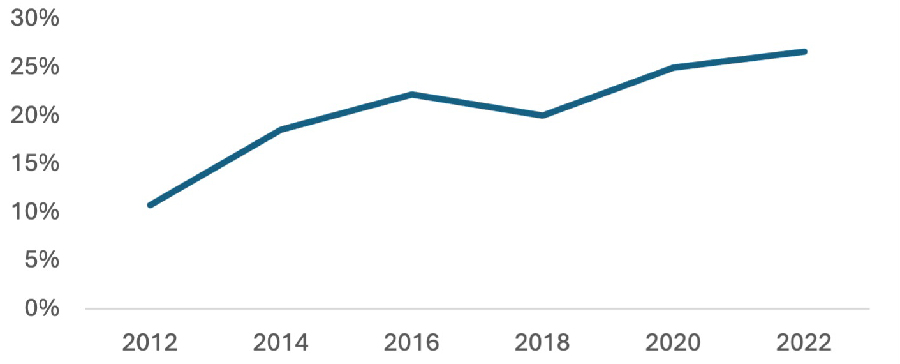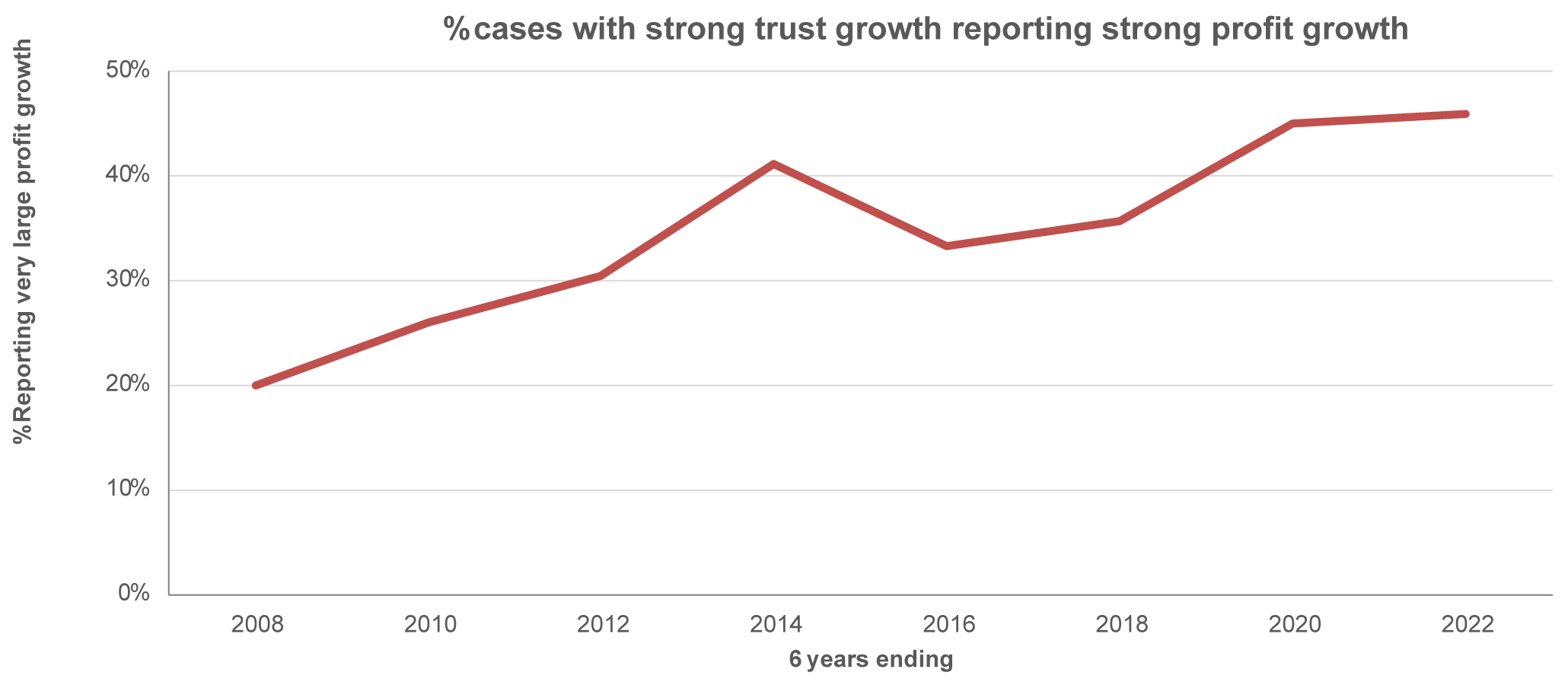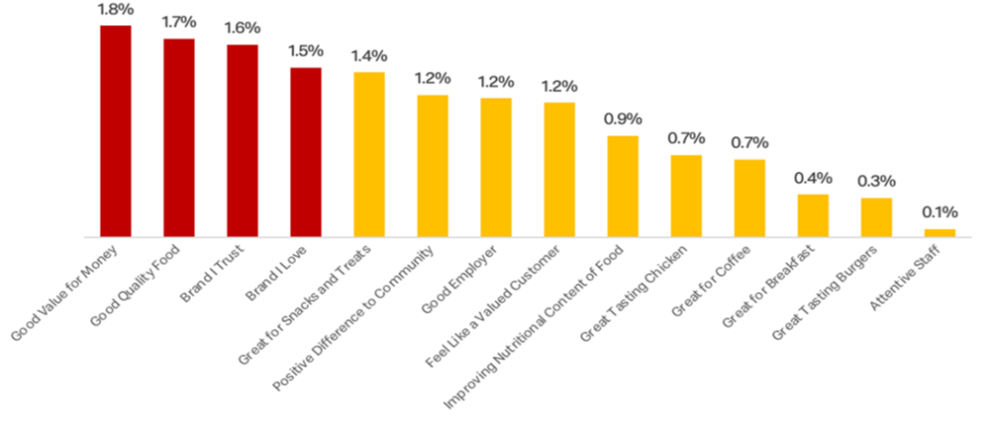Over the last decade, the percentage of IPA Effectiveness Awards entries that have included trust as one of the objectives for communications has risen markedly.
Whereas in 2012 just 11% of entries cited maintaining or building trust as a sole or primary communications objective, in the most recent Awards in 2022, this proportion was more than double at 25%. It will be interesting to see whether this year’s Awards show another increase.
% of awards entries where trust is sole/primary brand objective

Cases in point
Among IPA Effectiveness Award-winning cases, there have been some key papers in recent years that have brought to life what trust can mean for businesses. I would highlight three cases that made good use of data to tell their stories about why effective communications to increase brand trust contributed to quantifiable financial benefits (as well as providing other desirable non-financial impacts for the brands involved).
First, the Barclays paper, ‘Purpose Pays,’ (2018, Silver) gives deep insight into the fallout on the banking brand from the 2008-9 financial crash and banking scandals, such as that connected to LIBOR (London Interbank Offer Rate), and explains how Barclays used purpose-driven advertising and training initiatives in digital skills for the public, to increase trust and increase consideration, sales and profits.
The next case is ‘From running shops to serving customers: The Tesco turnaround story,’ (202o, Grand Prix). This case covers the period from 2015, when Tesco reported the biggest loss in UK corporate history and its trust scores hit a new low, through the following years when the supermarket turned around its fortunes by shifting perceptions of trust, value for money, and product quality (especially in food).
And most recently, there is the McDonald's UK case study analysing 15 years of its campaigns, ‘How we got customers lovin’ it…’ (2022, Gold), which lays out how the brand initially lost the love and trust of the British public, leading to low brand measure scores and stagnant sales. This was turned around using campaigns that sparked emotion and connected with audiences, with subsequent increases in brand trust identified as one of the leading drivers of sales increases at McDonald’s (see below).
How did the cases measure trust?
Compared to other brand metrics such as awareness or consideration, levels of brand trust are arguably a more complex set of audience reactions to assess. IPA cases have often used quantitative brand tracking studies to measure trust.
Barclays used Millward Brown brand tracking, which showed the scale of the problem the bank was up against after the 2012 LIBOR scandal when the gap widened between trust for Barclays and the average score across its competitors.
Over its very long-term case, McDonald’s used for different periods, TNS and Kantar, to measure trust (along with value, brand love, and quality) to evaluate changes in its overall brand image.
Tesco used YouGov’s brand index ‘reputation’ scores as a proxy for trust in its business, with its score going negative in late 2014, but consistently moving upwards over the period of the case.
Why trust matters financially
There is good evidence that increases in brand trust are linked to better business outcomes for the brand. Using the IPA Effectiveness Databank, Peter Field has charted the link between the rise in recent years in the percentage of IPA Effectiveness Awards cases reporting strong growth in trust and the percentage of cases reporting strong profit growth. This rise has been particularly notable in the last three Awards cycles, in the years when concerns over the spread of ‘fake news’ and scams on digital media have increased. Among the most recent Awards cases analysed in the Databank, brand trust has become the second most important brand metric linked to reported profit growth.
The link between trust and profit has grown especially strongly

Using an econometric model (or other modelling techniques), you can link the effect of increased brand metrics to business outcomes. In the McDonald’s paper, for instance, it was noted that brand ‘trust,’ alongside ‘value’ and ‘quality,’ were the brand metrics proven to have the strongest relationship with McDonald’s customer visits and sales growth, showing what an increase in trust does to the financial performance of the business.
Net sales impact of 10% increase in brand metric

Using knowledge of the financial value of trust to incorporate trust building into messaging helped McDonald’s double the ROI from advertising between 2007 and 2021.
The Barclays paper, highlighted that after ease of use, being trustworthy was the second strongest driver of consideration across the retail banking sector.
Key drivers of consideration in retail banking (strongest factors in driving consideration in ascending order)
Source: Barclays, IPA Effectiveness Awards case, 2018
These cases make it clear that improving brand trust can pay back financially (both in the short and the long term), but also in terms of longer and broader manifold effects felt across the wider business. For example, Tesco reported its colleague engagement score grew from 70 in August 2014 to 83 in January 2019, and viewpoint of the brand among its suppliers also improved.
The rise of trust as a primary objective in Effectiveness Awards entries underscores its growing importance in the era when there is so much focus on brand authenticity and transparency.
The examples cited above are just some of the IPA Effectiveness Awards cases that demonstrate how using effective communications to nurture brand trust among sought-after consumers can translate into significant financial benefits.
The opinions expressed here are those of the authors and were submitted in accordance with the IPA terms and conditions regarding the uploading and contribution of content to the IPA newsletters, IPA website, or other IPA media, and should not be interpreted as representing the opinion of the IPA.



